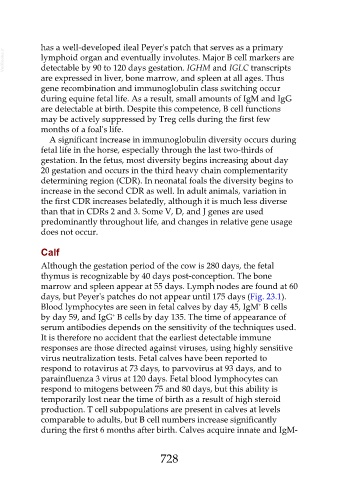Page 728 - Veterinary Immunology, 10th Edition
P. 728
has a well-developed ileal Peyer's patch that serves as a primary
VetBooks.ir lymphoid organ and eventually involutes. Major B cell markers are
detectable by 90 to 120 days gestation. IGHM and IGLC transcripts
are expressed in liver, bone marrow, and spleen at all ages. Thus
gene recombination and immunoglobulin class switching occur
during equine fetal life. As a result, small amounts of IgM and IgG
are detectable at birth. Despite this competence, B cell functions
may be actively suppressed by Treg cells during the first few
months of a foal's life.
A significant increase in immunoglobulin diversity occurs during
fetal life in the horse, especially through the last two-thirds of
gestation. In the fetus, most diversity begins increasing about day
20 gestation and occurs in the third heavy chain complementarity
determining region (CDR). In neonatal foals the diversity begins to
increase in the second CDR as well. In adult animals, variation in
the first CDR increases belatedly, although it is much less diverse
than that in CDRs 2 and 3. Some V, D, and J genes are used
predominantly throughout life, and changes in relative gene usage
does not occur.
Calf
Although the gestation period of the cow is 280 days, the fetal
thymus is recognizable by 40 days post-conception. The bone
marrow and spleen appear at 55 days. Lymph nodes are found at 60
days, but Peyer's patches do not appear until 175 days (Fig. 23.1).
+
Blood lymphocytes are seen in fetal calves by day 45, IgM B cells
+
by day 59, and IgG B cells by day 135. The time of appearance of
serum antibodies depends on the sensitivity of the techniques used.
It is therefore no accident that the earliest detectable immune
responses are those directed against viruses, using highly sensitive
virus neutralization tests. Fetal calves have been reported to
respond to rotavirus at 73 days, to parvovirus at 93 days, and to
parainfluenza 3 virus at 120 days. Fetal blood lymphocytes can
respond to mitogens between 75 and 80 days, but this ability is
temporarily lost near the time of birth as a result of high steroid
production. T cell subpopulations are present in calves at levels
comparable to adults, but B cell numbers increase significantly
during the first 6 months after birth. Calves acquire innate and IgM-
728

